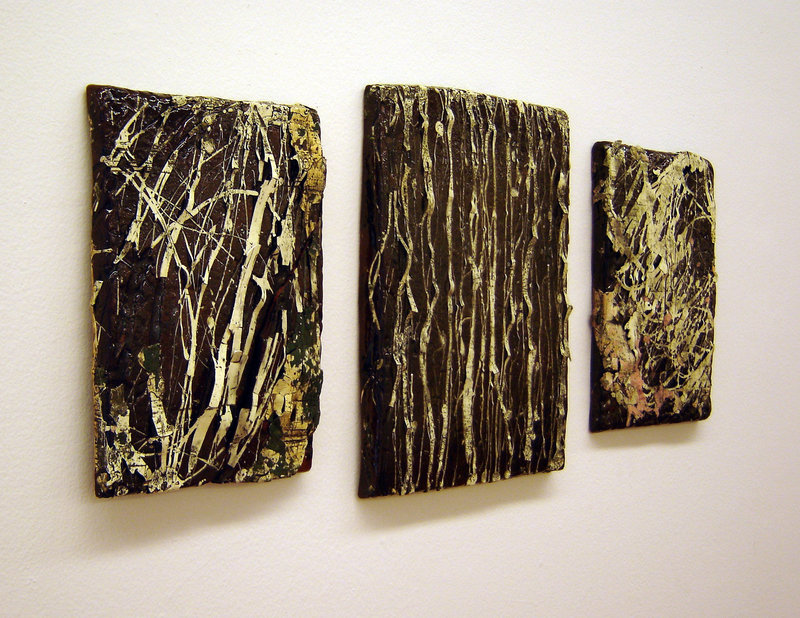Maine art has always been painterly. An odd word, “painterly” is a very positive term that connotes a looseness expressive both of style and improvisation.
As the art world has seemed to move away from “painterliness” on the diverging branches of craftsmanship and conceptualism, Maine has remained fundamentally concerned with painting.
The mirrors show at MECA’s ICA, for example, is cutting-edge contemporary art, but virtually all of its content is based in the logic of painting. Ceramics (which is very strong in Maine) can take on issues of design, sculpture or painting, but what we primarily sense from Maine’s best clay artists is a healthy and loving relationship with painting.
The most painterly show I have seen in a long time is the exhibition “Traces” by ceramic artist Jonathan Mess.
“Traces” features 36 astoundingly affordable wall slabs hung as a painting show in the handsome, “white cube”-style Two Point Gallery in Portland.
What we see in “Traces” is actually abstract expressionist painting, but in clay. The works are dense abstractions with swirling lines, looping calligraphic marks and energetic bolts of organic color, all densely bound together as heavily textured fields of painting.
For ceramic fans, the connection to abstract expressionism is not surprising. After all, America’s greatest clay artist, Peter Voulkos, applied the logic and strategies of ab-ex to ceramics with great success.
The most famous ab-ex painter was Jackson Pollock, and his presence can’t be missed in Mess’ work. Many of the boldly snaking lines were clearly made using Pollock’s famous approach of working flat and dripping paint from a stick. We also see echoes of Willem de Kooning and so many of the other great American painters in Mess’ brushwork, scraped and smeared passages and complex layers of color.
However, Mess has options the abstract expressionist painters didn’t. He scrapes, furrows and extrudes his slabs as well as building onto them — revealing additive and subtractive sculptural logic. In “Large Traces No. 12,” for example, Mess curls a poured line of black slip (a mostly talc liquid that can be poured into a mold or tinted to use like paint) over similar shapes carved into the surface of the clay. The effect is a literal weaving of the painted line into the surface.
Mess’ inventiveness ironically reminds us that ab-ex largely faded because it became a facile vehicle with too little new ground to uncover, so the artists lost interest. Paint as a material is much less complex than the low-fire materials Mess orchestrates (glazes, slips, fluxes, etc).
The surfaces can be flat, three-dimensional, cracked, matte, glossy, transparent, curved, crazed or any combination of these with a virtually unlimited palette. Mess even does something like collage. The composition of “Large Traces No. 6,” for example, hinges on a constellation of angular orange shards running up the left side of the composition.
The technical aspect of ceramics adds a back-end depth to Mess’ art without impinging on his ability to work spontaneously. In fact, the drying schedule of the slabs and surface materials adds a real-time urgency that, when coupled with the finalizing fact of firing, takes his works past the anxiety of arbitrariness that haunts many painters.
The fact that Mess creates his own “canvases” out of clay creates a sense of unity that would no doubt make painters such as Pollock churn with envy.
But does all this add up to good painting?
In Mess’ case, absolutely yes. Not only is he a skilled sculptor and ceramic artist, he also has a great eye and a surprisingly sharp visual intelligence. The works are boldly energetic and visually exciting, but they are also confident, handsome and sophisticated.
One of my favorite works is “Large Traces No. 4.” It has the rainy-day sweep of downward white trickles on a black field. (It reminded me at once of the paintings of Pat Steir). The white lines, however, did not reduce as much as the slab, and so they bow out in sculptural arcs, adding a wisp of dazzling dynamism to an otherwise elegantly calm composition.
Considering the move towards craftsmanship and more technical media like encaustic, it’s not surprising to see strong “painting” shows in alternative media, but “Traces” is so exciting, dynamic and accessible, it is one of my favorite shows of the past year.
Everyone should see this show.
Freelance writer Daniel Kany is an art historian who lives in Cumberland. He can be contacted at:
dankany@gmail.com
Send questions/comments to the editors.



Comments are no longer available on this story